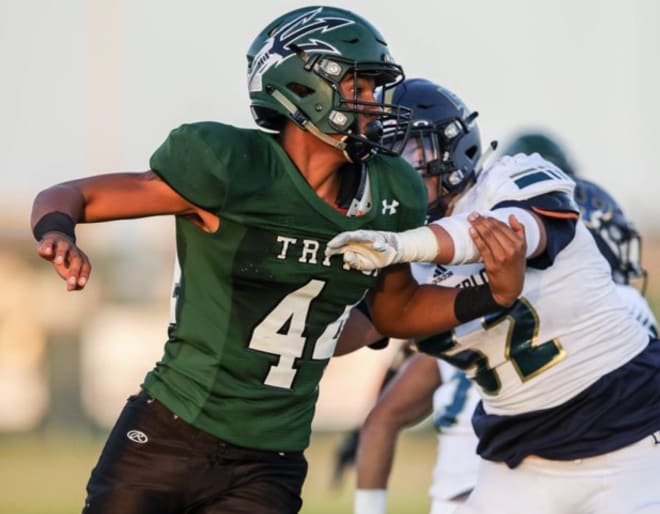Friday Five: How Will ‘Project’ Players Recruited During Dead Period Fare?
They aren’t the most highly rated players in the class, but the careers of defensive linemen Jason Onye, Will Schweitzer and Devin Aupiu will be captivating to follow even if none is likely to play much in 2021. It’s because of what they represented in a weird recruiting cycle.
Notre Dame’s staff never met Aupiu in person before he enrolled in January. It saw Onye and Schweitzer only briefly when stopping by their schools. None had a senior season. None took a formal recruiting visit to Notre Dame.
The Irish coaches, like every other team’s, had to make concessions and take players who they haven’t met, haven’t watched live or who haven’t visited campus.

It leads to big-picture questions. Will we look back at the 2021 class in four years and see a lot more players who struggled at their original schools because of the unique circumstances of their recruitments? Will the absence of important parts of the evaluation process lead to more misses? Will there be more misses with “project” players? There isn’t an easy way to quantify any of those questions, but the answer could plausibly be yes.
Aupiu, Schweitzer and Onye are closer to projects than polished players. They’ll take some work and may need some time. Each is likely to redshirt this year. Notre Dame and defensive line coach Mike Elston in particular have excelled with turning those type of recruits into contributors and starters. They have an eye for taking the right developmental projects and helping them get close to the ceiling they foresaw.
Ade Ogundeji, the former Western Michigan commit turned NFL Draft pick, is the best example. Three-year starters Myron Tagovailoa-Amosa and Kurt Hinish were three-stars too.
But Notre Dame had a standard evaluation process when recruiting them. The Irish are a better bet to succeed with recruiting those type of players in pandemic circumstances than most other teams. Yet one wonders if the bizarre 2021 cycle stacks the deck against any such bet.
Notre Dame’s entire 2021 defensive end class is made up of longer-term developmental players, so it’s important for future seasons that at least one of Aupiu, Schweitzer or Onye becomes a trustworthy player.
2. Cain Madden
Notre Dame wants to fill out its 2021 roster with a graduate transfer or two. The candidates are former Tulsa cornerback Akayleb Evans and ex-Marshall guard Cain Madden. They’re additions into competitions at corner and guard more than hole-pluggers or locks to start.
Of the two, the path for Madden to start at Notre Dame seems clearer.
First, his pedigree stands out. He was an Associated Press second-team All-American last year. No Football Bowl Subdivision guard had a higher Pro Football Focus run-blocking grade than his 93.0. Anything near that level of run-blocking would be welcomed on a line that replaces four starters and is paving the way for a backfield that might be the best of the Brian Kelly era.
Guard also feels like the bigger need. Notre Dame badly wanted departed starter Aaron Banks back for a fifth season. The drop-off from him to his replacement could be steeper than the difference between departed boundary corner Nick McCloud and his successor. Madden’s competition is freshman Rocco Spindler, junior Andrew Kristofic, junior Quinn Carroll and senior John Dirksen. None has played meaningful college snaps.
Spindler impressed this spring, but he will go through some bumps like any other freshman would if he starts. He might not even be the only freshman starter on the line — a good sign for 2022 and beyond but not necessarily for 2021. None of the other three guards separated from the pack.
All told, it feels like a spot where a three-year starter and sixth-year senior can alleviate some pressure.
Corner is the team’s youngest and least experienced position, so there is opportunity for Evans. But he would have to fend off junior Cam Hart, one of the spring’s risers, or unseat Clarence Lewis at field corner after Lewis grabbed that starting role as a freshman last year.
3. Time In Pocket
Quarterback Jack Coan doesn’t own Ian Book’s improvisation skills or running ability, which could make life a bit more difficult behind a rebuilt Notre Dame offensive line.
He does, though, have a translatable skill from his time at Wisconsin that could help him in that setting.
In 2019, Coan was one of the country’s best passers when he unloaded the ball in 2.5 or fewer seconds after the snap. His 113.8 passer rating on those throws was 15th among FBS quarterbacks (minimum 350 drop-backs), per PFF. His 74.7 completion rate was 18th and his 8.5 yards per attempt ranked fifth.
Coan threw the ball in less than 2.5 seconds on 55.4 percent of his drop-backs in 2019, which ranked 14th among qualified passers. He dropped back 373 times in 2019, and on 206 of those, he threw a pass (or was sacked) within the 2.5-second threshold. That’s largely a function of Wisconsin’s offense.
If Notre Dame’s passing offense contains a lot of quick-hitting throws — especially early in the season as the line plays its first few games together — it can have faith in Coan’s ability to process information quickly and unload a good throw. Wisconsin’s 2019 offensive line was effective, but Coan was still pressured 37 times on those 206 drop-backs. He dealt with periodic heat on quick-hitters and succeeded.
4. Roster Crunch
ESPN’s crew of college football reporters took a deep dive into the new roster management challenges birthed by the COVID-19 extra year of eligibility and the uptick in transfers. It’s a thorough read (ESPN+ required) on an issue that will only gain more public attention in the coming seasons.
I want to focus on one aspect described in the story: dwindling scholarships available for high school players. The theory coaches professed is recruiting transfers with more frequency in this age of increased transfers will lead to fewer spots in classes for high school recruits.
Like high school prospects, transfers are counted toward the 25-player limit for each signing class. That’s the main reason we hear tales of transfers who enter the portal but can’t find a home or land at a lower level than they expected. With more transfers available, though, coaches will be hard-pressed not to take a longer look and add a few more.
I’m not a believer in a mass decrease in opportunity for high school players, though. It would be quite a pivot for coaches to make when we hear them utter variations of “recruiting is the lifeblood of a program” year-round. That’s not to say it won’t happen at all, but I’ll believe it’s severe when I see it.
The problem that could grow is the inability to replace transfers at the same rate they lose them. As we’ve seen, attrition rate is higher nationally. If 10 players enter the portal but a team has already signed 20 initial counters, that team is likely looking at unused scholarships for the upcoming season. No one wins there.
Something has to give. Changes to the 85-player limit would be expensive for some schools, and that cap is a competitive balance key.
The better target may be the 25-counter cap. Among the proposals coaches suggested in the ESPN story are a 50-player cap over two years, eliminating the cap, not having transfers count toward the 25 or getting a spot back for every player who enters the portal in good academic standing. An adjustment there would help ensure there is no high school recruiting drop-off and would open more spots for transfers.
But can the initial counter rule be adjusted without incentivizing run-offs to create more space and sign bigger classes? That’s the consequence to be wary of when discussing any change.
The fewer spots for high school players issue seems like less of a concern with Notre Dame because the Irish have shown little interest in taking undergrad transfers. Their portal exploits in recent years have been graduate transfers as one- or two-year additions. Their two transfer targets right now are graduates.
5. Elijah Taylor
If new basketball “defensive coordinator” Anthony Solomon notices anyone who stands out on that end of the floor this offseason, that player ought to have a spot in next year’s rotation. His task, after all, is to improve a woeful defense.
Defense might be freshman guard Blake Wesley’s ticket to minutes in a busy backcourt. I think it could be sophomore forward Elijah Taylor’s as well, as long as he’s not slowed by the ankle surgery that wiped out his freshman year. His high school tape shows quick enough feet to make an impact on that end and hold his own in pick-and-roll coverage.
“At worst, he is a shot changer, rebounder and finisher in the lane,” former Rivals recruiting analyst Corey Evans wrote when Taylor signed.
Yale graduate transfer Paul Atkinson Jr. will start at the five this year, but the backup situation is in flux. Atkinson was a solid post-up defender at Yale, but not really a rim protector. Last year, Notre Dame usually went small with Nate Laszewski sliding over from the four when center Juwan Durham wasn’t in the game. It created good spacing, but wasn’t a strong defensive lineup.
Having a viable option to play big without Atkinson on the floor and a defensive stopper forward would help Solomon’s defensive reboot.

----
• Learn more about our print and digital publication, Blue & Gold Illustrated.
• Watch our videos and subscribe to our YouTube channel.
• Sign up for Blue & Gold's news alerts and daily newsletter.
• Subscribe to our podcast on Apple Podcasts.
• Follow us on Twitter: @BGINews, @BGI_LouSomogyi, @Rivals_Singer, @PatrickEngel_ and @ToddBurlage.
• Like us on Facebook.



